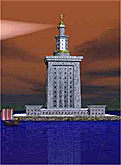 |
 |
 |
 |
February 21, 2000 |
|||||||||||||||||||||||||||||||||||||||||||||||
|
THE PHAROS |
|
|||||||||||||||||||||||||||||||||||||||||||||||
|
Completed 20 years later, during the reign of Soter's son, Ptolemy Philadephus, the structure was far more than merely a lighthouse. It became THE lighthouse, and one of the seven wonders of the ancient world. Taking over the name of its island, the structure was known as The Great Pharos Lighthouse, or simply, The Pharos. Indeed, "faro" is the basis for the word "lighthouse" in the romance languages. Contemporary accounts, such as those by Strabo and Pliny the Elder, provide a brief description of the "tower" and the magnificent white marble cover. They tell us how its mysterious mirror could reflect the light miles away. Legend holds that the mirror was also used to detect and burn enemy ships before they could reach the shore. A raging fire provided the nocturnal light source. In 1166, an Arab traveler, Abou-Haggag Al-Andaloussi, visited the lighthouse, and recorded his observations in detail. It was composed of three stages: The lowest square, 183 feet high with a cylindrical core (employed as a shaft to raise fuel to the top); the middle octagonal, with a side length of 60 feet and a height of 90 feet; and the third circular, 24 feet high. In ancient times, a statue of Poseidon adorned the summit. The total height of the building, including the foundation base, was about 384 feet--equivalent to a 40-story modern building. In fact, The Pharos looked more like an early 20th century skyscraper than it did a typical lighthouse. The structure was designed by Sostrates of Knidos, who wanted his name on the lighthouse. Ptolemy refused, wanting only HIS name on it, but Sostrates found a way around the king. He had the inscription: SOSTRATES SON OF DEXIPHANES OF KNIDOS ON BEHALF OF ALL MARINERS TO THE SAVIOR GODS chiseled into the foundation, then covered it with plaster. Into the plaster was chiseled Ptolemy's name. With time, the plaster aged and chipped away, revealing Sostrates' declaration. The Pharos was a tourist attraction, as well as a navigational aid. Food was sold to visitors on the observation platform at the top of the first level. A smaller balcony provided an impressive view, surely worth the climb, from the top of the eight-sided tower, 300 feet above the sea. The Pharos collapsed in 1326, after numerous earthquakes. In 1994, a team of divers, using the latest in high-tech gear, explored the waters off Alexandria. They did find blocks of stone that appeared to have come from a large building. Statues were also located that may have stood at the base of The Pharos. Much of the material found seems to predate the lighthouse. It is thought that stone recycled from even older buildings was used in constructing The Pharos. A September, 1998 story in London's Independent tells of a French project to rebuild The Pharos, some distance from the original site, to allow continuing archeological excavations. The project is scheduled to be completed this year. A wonder of the world shall return!! |
|
|
|
|
Last Update:
|

 The
time is 290 B.C. The place is Alexandria. In this city there is
a marvelous double harbor, serving both the Nile River and the
Mediterranean Sea. For reasons of safety, ego, and to increase
commerce, Ptolemy Soter, ruler of Egypt, orders construction of
a lighthouse on the nearby island of Pharos.
The
time is 290 B.C. The place is Alexandria. In this city there is
a marvelous double harbor, serving both the Nile River and the
Mediterranean Sea. For reasons of safety, ego, and to increase
commerce, Ptolemy Soter, ruler of Egypt, orders construction of
a lighthouse on the nearby island of Pharos.
